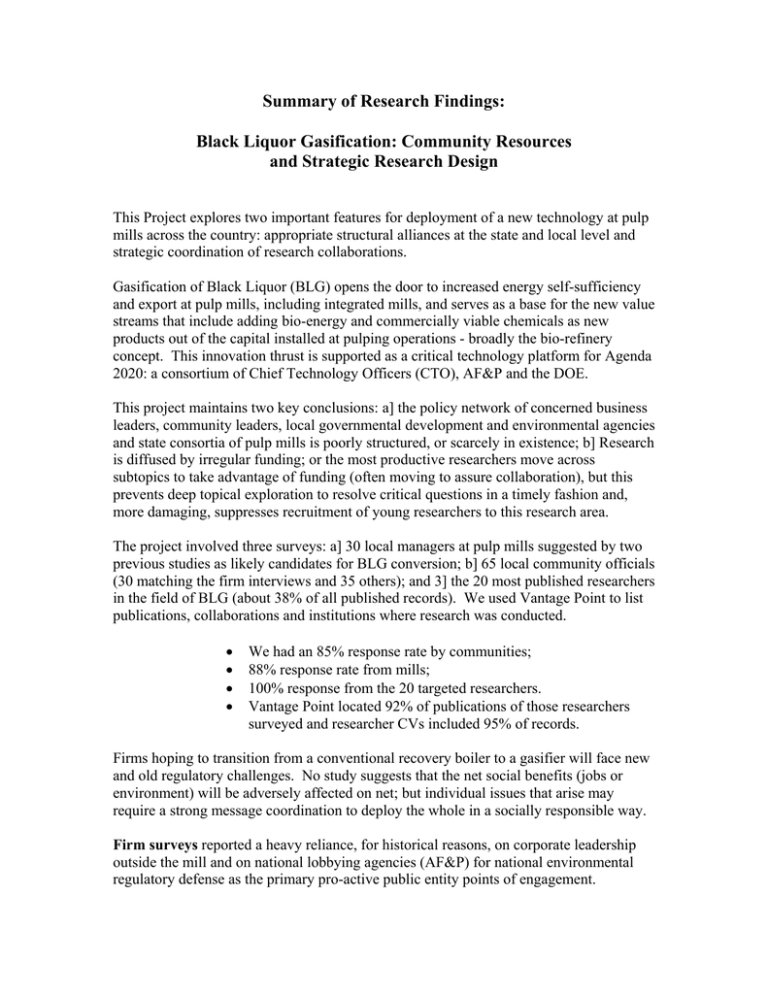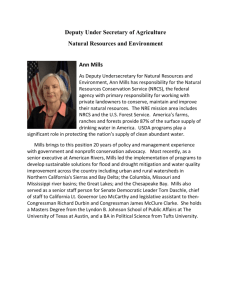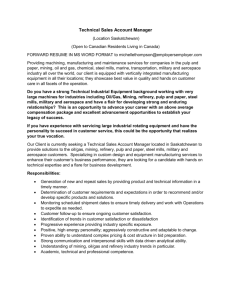Summary of Research Findings: Black Liquor Gasification: Community Resources
advertisement

Summary of Research Findings: Black Liquor Gasification: Community Resources and Strategic Research Design This Project explores two important features for deployment of a new technology at pulp mills across the country: appropriate structural alliances at the state and local level and strategic coordination of research collaborations. Gasification of Black Liquor (BLG) opens the door to increased energy self-sufficiency and export at pulp mills, including integrated mills, and serves as a base for the new value streams that include adding bio-energy and commercially viable chemicals as new products out of the capital installed at pulping operations - broadly the bio-refinery concept. This innovation thrust is supported as a critical technology platform for Agenda 2020: a consortium of Chief Technology Officers (CTO), AF&P and the DOE. This project maintains two key conclusions: a] the policy network of concerned business leaders, community leaders, local governmental development and environmental agencies and state consortia of pulp mills is poorly structured, or scarcely in existence; b] Research is diffused by irregular funding; or the most productive researchers move across subtopics to take advantage of funding (often moving to assure collaboration), but this prevents deep topical exploration to resolve critical questions in a timely fashion and, more damaging, suppresses recruitment of young researchers to this research area. The project involved three surveys: a] 30 local managers at pulp mills suggested by two previous studies as likely candidates for BLG conversion; b] 65 local community officials (30 matching the firm interviews and 35 others); and 3] the 20 most published researchers in the field of BLG (about 38% of all published records). We used Vantage Point to list publications, collaborations and institutions where research was conducted. • • • • We had an 85% response rate by communities; 88% response rate from mills; 100% response from the 20 targeted researchers. Vantage Point located 92% of publications of those researchers surveyed and researcher CVs included 95% of records. Firms hoping to transition from a conventional recovery boiler to a gasifier will face new and old regulatory challenges. No study suggests that the net social benefits (jobs or environment) will be adversely affected on net; but individual issues that arise may require a strong message coordination to deploy the whole in a socially responsible way. Firm surveys reported a heavy reliance, for historical reasons, on corporate leadership outside the mill and on national lobbying agencies (AF&P) for national environmental regulatory defense as the primary pro-active public entity points of engagement. • This has led local mills to establish very good relations with local communities; but on their reports this is limited to defensive strategies, not pro-active management resources. Communities report high favorable of their pulp mills. They report local development resources, human and financial, that can be used to assist pulp mill initiatives. They report experience in connecting to state agents to support favored businesses. • • Connections extend beyond local lobbying to a vehicle that can frame a policy network and mobilize consortia state-wide; These pro-actively support initiatives that make the industries more competitive overall and more technically advanced, especially if efforts lead to the need for a technically advanced workforce. As other research reports support from USDA to emerging initiatives that utilize extension resources, some positive policy and research funding response may follow integrated use of extension personnel. We find three reasons to suggest sufficient resources are in place to affect a result to mobilize better local and state resources to a pro-active policy network / consortium to advance BLG and the bio-refinery generally. 1. First, the business managers and public personnel are in place. • • • • 2. Managerial morale at pulp mills is surprisingly high. Technical managers report non-hierarchic and team oriented, especially in comparison to the pre-1990 condition. The record of success and adaptability of mill management cemented throughout the 1990s, making this an important human capital resource. Matching this, community resources have strong state connections. These include collaboration with the Agricultural Extension Service, the entity most reported to initiate on their own contact with pulp mills and to make formal institutional ties to state institutions: universities, state departments of agriculture and forestry and state environmental protection divisions. Second, prior CPBIS initiatives suggest prospects for improvement: • • CPBIS already operates as a complimentary resource to coordinate Community Colleges to advance a technically advanced workforce (TAW), using NSF funds to establish industry-public hybrid collaborations to affect a tactical objective of pulp mills. Comparisons of industry-public agency coordination between Scandinavia and the U.S. find a more adversarial and less efficient structure in achieving public and private ends in the industry. 3. Third, results confirm political science theories of the corporatism of European policy-making versus elitist or various pluralist political forms in the U.S. This suggests, from this research, limited prospects for National level public-private coordination with the managerial adaptability along the more efficient corporatist European lines. Research into ‘corporatist’ coordination structures in the US at the state and municipal level is in its infancy, but limited research suggests prospects for successful public-private integration at these levels of government where parliamentary or quasi-parliamentary structures may operate. • • Survey evidence in this work contributes to this evolving research to suggest reasonable prospects to deploy mill and industry resources to state and local pro-active relationships to form effective consortia that contribute to final deployment of new technologies. Whether integration can shape the policy scope for an effective policynetwork around green technologies from the pulp and paper industry (bottom up to the national agenda) is beyond the reach of this work. While the local level has attractive features to mobilize the resources to affect a transition from a recovery boiler to a gasifier, some obstacles and opportunities inside the mill management structure appeared that may be important to a paper company considering conversion of one of its mills. • • • • • FINDING: Continued innovation in the 1990s extended the reported productive life of recovery boilers far beyond what studies expect. IMPLICATION: The expectation that a host of mills will be coming on line from 2012-2020 due to full recovery boiler depreciation is not likely to happen. This ‘natural’ opportunity to introduce BLG may not occur. FINDING: Much of the reported good spirits and sense of management camaraderie emerged from facing challenges to extend the life of the boiler. Technical managers are mill managers are very protective of boiler operations to extend its productive life. IMPLICATION 1: Mills resist innovations that disrupt the recovery boiler process. A published example is the profitable use of borates to partly causticize in boilers. We find mills resist due to the possible risks to boiler operations and productive life. IMPLICATION 2: A ‘natural’ opportunity to introduce BLG is incrementally. 58% of the mills identified as ‘likely conversions’ reported that boiler capacity is the obstacle to increased pulp production. When asked, 80% reported they would seriously consider a gasifier as an ‘addon’ to supplement the boiler and to take advantage of excess lime cycle capacity. Excess capacity varied between 300 – 600 tons of pulp per day – a substantial increment given average production for this group fell just below 1500 tons per day. Suggested Deployment Concern: If incremental implementation is rejected for many mills and full conversion (to a bio-refinery for example) is required, to commence conversion may require preserving on site human capital. An adaptable, problem-solving team is in place; it has good (and under-exploited) relations with local communities and states; and it remains innovative. Leadership from corporate centers to engage managers and technical managers at mills to mobilize its structure and escalate its capacity to galvanize public support for an effective public-private policy network could be a key element for fluid and successful BLG deployment and mill conversion. Evaluation of Research Coordination We find a very productive research area around Black Liquor Gasification that builds on past research on the properties of black liquor in a system that employs the convention recovery boiler. Many contributors to current BLG research came from this background and new researchers enter through BLG funding. Gasifier Industry: At the beginning of the research period under study: 1991 – 2003, three commercially developed gasifier technologies were active: a low Temperature MTCI technology (US made), a high temperature gasifier (Swedish made), and a continuous fluidized bed gasifier (US made). Peer-reviewed work by the end of the decade and over the last 5 years clearly emphasizes the high temperature Swedish technology. A pilot, incremental high temperature gasifier has been operating for two years at a Weyerhaeuser mill in New Bern, NC with no operating obstacles over the last 12-13 months. The MTCI technology is still alive as a competitor, but Kellogg, Brown and Root withdrew operations on their system, and they idled fully their gasifier lab. Our results are not conclusive as to the causal affect of research coordination on the choice of the current front-runner technology; but the structure of funding, its continuity and its topical consistency (ramping up and ramping down) did favor this technology. Research Networks: We tracked the collaborations of researchers in the peer-reviewed published literature that included reviewed conference proceedings, Theses and Dissertations, annual reports to major funding agencies and journal publications. Private research under confidential restrictions could not be accessed, except through conference papers when a fundamental property of Black Liquor and its thermal, pyrolytic and kinetic processes was discovered. Due to the more fluid public/private infrastructure in Scandinavia, more of the private sponsored R&D shows up in our review. So our scope of research is to evaluate the public research monies, strategy and management which inter-face with private initiatives. Scope of This Work To date the basic static analysis has been completed, the type of analysis common to existing network theory. As we proceeded, we realized that we had data of sufficient quality to simulate likely predictions of how the field could advance on various topics by using public resources to encourage specific collaborations (between institutions or persons). Exploratory research funded by this project demonstrated that highly selective but quite modest information is needed to make predictions and conduct a dynamic analysis (under review) that can quickly follow-up this study beyond its scope of work and will proceed at the end of this year. DATA: We searched 410 records on gasification and properties of black liquor over the period 1992 to 2003. We had data on the type of publications (conference proceeding, journal article, reviewed report update), the affiliation of the first author, a list of all authors. In a survey of top publishers, we also matched publications to specific sponsored projects; the size of the project; the title of the project; the dates of the project; the PIs and other main researchers of note by the scholar surveyed. Collaboration Network Structure: The structure of the network uses standard tools for social networks. In general for this research network, we find several active centers of work around particular topics and sub-topics; but there are key concerns. • • • • • • • • • • • • • Funding has been sporadic and moved rapidly from topic to topic; On average, the most productive and connected scholars did not specialize; Restrictions between Europe, Canada and the US on intermingled funds severely impaired key collaborations; A drop in DOE funds in the early 1990s was offset by a strong Finnish Consortia that was formed for a long-term program commitment but caused a drop in momentum in the US; Institutional affiliations indicate that many productive US scholars moved between Sweden, Finland and the US and shifted topics as they moved; Few new scholars entered the field until DOE funding returned the middle to late 1990s; Funding resurgence in the mid-1990s by USDOE emphasized different topics, forcing scholars to widen rather than continue to deepen explorations; Many key ‘obstacle topics’ listed in conferences in the early 1990s saw little progress until recently: tars (gas clean-up) and auto-causticizing specifically targeted to gasification, as little direct funding on the topics was committed; Progress on kinetics, a key obstacle, does appear to be cumulative and linear due to US-Finish-Swedish collaborations; Few persons from outside the discipline that can function as ‘small world’ connections appear in this network; We located two candidates for small world connections (outsiders brought in): a connection to a systems-energy balance engineer and an expert in aerosols The research network is not as hierarchic as other more mature social networks. The collaborations that show the most expected progress on topic areas listed as important occur between recently emerging / emerged scholars (connecting lieutenants rather than generals). • • The absence of inter-disciplinary work (non-chemical engineers) is striking compared to other research networks. We cannot assess the implications of this characteristic; Comparative statics (the network in 1998 to 2003), not to be confused with dynamics, shows that the most successful scholars and most improved scholars are those who became more centrally connected (within fewer degrees of separation to all researchers in the network). This dominated funding, institutional affiliation, number of co-authors and topic (sub-topic) of research. Funding coordination appears to strongly impact publication success by topic area. The network is relatively dense (many connections) and suggests many opportunities to coordinate better. Researchers themselves invented institutions such as the international semi-annual chemical recovery conference to reduce the losses from productivity gaps. Follow-up: We have invented a Bayesian estimator to complete some dynamic analysis that will provide an individualized prediction of the chances of that particular research collaboration on a particular topic will generate publications along three quality categories [conference paper, peer-reviewed article or designated as an ‘important work’ by using researcher designations of important works in their surveys] and expected funding levels (at an order of magnitude required). The process uses a cellular automata technique to individualize productivity predictions rather than single system analytic estimator of network dynamics. Existing methods treat connections the same (i.e. disease spread predictions) with are more naturally uniform. This is the first attempt we know of to explore social network dynamics with this degree of individuality. We hope to gain sharper insights into or predictions of the impact of public funded research and the entry or exit of researchers from this topic area. The survey was designed to collect critical information with the least effort in a survey based on proof of concept simulation experiments funded by this project presented at the Sloan conference and now under review. Publications Outlets: We have committed to five journal submissions: “Gasification Deployment and Transition at Pulp Mills” to TAPPI; “Creating Local Policy Networks for Green Technology Development at pulp and paper Mills” to Journal of Public Management; “Strategic Network Dynamics: A cellular automata approach” to Social Networks (in review); “Network Positioning in Academic Careers: Beyond funding and number of collaborations” to Research Evaluation; “Funding Bio-Energy Technologies: A Bayesian-Network Approach to Make Strategic Collaborations” to Resources and Energy. Presentations, 2004: Farmer, Michael C. "A proposed approach to making strategic research connections: Implementing Research Funding Policy in a Dynamic Network.” Sloan Foundation Annual Conference on Technology Innovation Strategies. Atlanta, Ga. March, 2004. Farmer, Michael C. “Environmental Regulatory Cooperation at the local level: Implications for Technology Adoption and US Pulp Mill Conversion,” International Chemical Recovery Conference. TAPPI. Charleston, S.C. June, 2004. Farmer, Michael C. “Framing a research and implementation strategy for the bio-refinery conversion of US pulp mills” AGENDA 2020 Planning Conference. USDOE-Industry CTO Association on bio-energy development at US pulp and paper mills. Wash, D.C. September, 2004. Farmer, Michael C. “Bio-Mass Gasification as a National Forestry Initiative,” College of Forestry, Virginia Institute of Technology. October, 2004. Farmer, Michael C. “Management Readiness for Green Technology at US Pulp Mills,” National Research Center for Coal and Energy. West Virginia University. October, 2004. Farmer, Michael C. “Commercialization of the Bio-Refinery: Transition Opportunities and Obstacles at US Pulp Mills” IPST-CPBIS Techno-Business Conference. BioRefinery Platform. October, 2004. Papers 2004. Farmer, M.C. and Burke, S. 9/04 “Making Strategic Connections: Implementing Research Funding Policy in a Dynamic Network.” Submitted to: Social Networks. Kingsley, G. and Farmer. M.C. 4/04 “Embedding a hybrid: A Case Study of a pubicPrivate partnership in an Ohio venture capital operation.” Submitted to: International Journal of Technology Management. Status R&R (9/04). Farmer, Michael C. June, 2004. “Strategic Research Connections: Implementing Funding Policy in a Dynamic Network,” Conference Series Sloan Foundation Annual Conference on Technology Innovation Strategies.



